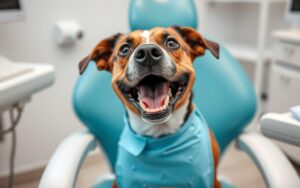
Did you know that trained sniffer dogs can detect certain types of cancer with an astonishing success rate of up to 117%? A study in 2017 showed that dogs can accurately find cancer through scent. This skill has sparked research into how dogs’ amazing sense of smell can help detect diseases early.
Dogs have up to 300 million olfactory receptors, much more than humans’ 5 million. This lets them sniff out specific smells from diseased cells, even at very low levels. By teaching dogs to link these smells to rewards, scientists have shown they can spot many diseases, including cancers, Parkinson’s, malaria, and COVID-19.
Key Takeaways: How Dogs Smell Diseases
- Dogs have an extraordinary sense of smell, with up to 300 million olfactory receptors compared to humans’ 5 million.
- Trained canines can detect certain types of cancer with remarkable accuracy, in some cases over 100%.
- Dogs can identify disease-related volatile organic compounds (VOCs) at extremely low concentrations, making them valuable in early disease detection.
- Research is exploring the use of medical detection dogs for a wide range of conditions, from cancer to Parkinson’s, malaria, and COVID-19.
- The science behind how dogs smell diseases involves their unique olfactory receptors and brain structure, as well as their ability to discriminate subtle scent differences.
- The Extraordinary Canine Nose
- How Dogs Smell Diseases
- Training Medical Detection Dogs
- Cancer Detection by Canine Olfaction
- Alerting Diabetes and Other Diseases
- Accuracy and Challenges
- Future Prospects: Electronic Noses and Standardization
- The Human-Canine Bond in Healthcare
- Conclusion: How Dogs Smell Diseases
- FAQ
The Extraordinary Canine Nose
Dogs have a much better sense of smell than humans. They have up to 300 million olfactory receptors, compared to our 5 million. Their brain’s olfactory bulb is also much larger, 40 times bigger than ours.
Olfactory Receptors and Brain Structure
This amazing sense of smell lets dogs pick up scents and chemical changes we can’t see. Their canine olfactory sensitivity is so sharp they can find specific volatile organic compounds (VOCs) from diseased cells in tiny amounts.
Superior Scent Discrimination
- Dogs have over 100 million sensory receptor sites in the nasal cavity compared to humans’ 6 million.
- The area of a dog’s brain that analyzes odors is about 40 times larger than that of a human’s.
- Dogs can smell anywhere from 1,000 to 10,000 times better than people.
- Dogs can identify other dogs they have not seen for years based on scent discrimination.
- Dogs can determine other dogs living in a neighborhood by sniffing a tree.
- Dogs can distinguish individuals by their unique innate scent.
Dogs’ amazing olfactory receptors and brain structure make them great at sniffing out different smells. This skill is very useful in medical detection work.
“Dogs have been shown to have a 99 percent success rate in detecting prostate cancer through sniffing patients’ urine samples.”
| Statistic | Value |
|---|---|
| Miniaturized detection system sensitivity | 200 times more sensitive than a dog’s nose |
| Potential disease sample testing | up to 5,000 samples |
| Cost per clinically tested disease sample | $1,000 |
| Dog and system success rate in detecting prostate cancer | higher than 70 percent |
How Dogs Smell Diseases
Dogs have an amazing sense of smell. They can pick up on tiny changes in the air, like in a person’s breath, sweat, and urine. These changes can show if someone has a health problem. Dogs learn to link certain smells with different diseases.
Detecting Volatile Organic Compounds
Dogs have a super strong sense of smell. They have about 220 million scent receptors, while humans have 5-10 million. This lets them find smells that are very faint, even in parts per trillion. These smells come from the body’s metabolic processes and can mean a disease is starting or getting worse.
Disease Biomarkers in Breath, Sweat, and Urine
- Studies show dogs can find breast cancer with 97% accuracy and lung cancer with 99% by smelling breath, sweat, or urine.
- Dogs can also spot people with narcolepsy, Parkinson’s disease, and COVID-19 by their unique smells.
- They can warn their owners about dangerous blood sugar levels in diabetes, helping avoid serious problems.
Dogs’ ability to find these disease signs is incredible. It shows how powerful their sense of smell is. This technology could change how we find and treat diseases early on.
“Dogs have over 220 million scent receptors, compared to 5-10 million in humans. Their ability to detect odors is 10,000 to 100,000 times stronger than humans.”
Training Medical Detection Dogs
Dogs can detect diseases thanks to a special training called medical detection dog training. This method uses their amazing sense of smell and their love for rewards.
Reward-Based Scent Association
The heart of this training is a reward-based system. It teaches dogs to find specific scents linked to diseases. Here’s how it works:
- Exposure to disease samples: Dogs meet samples from people with certain conditions, like cancer or diabetes.
- Scent association: They learn to connect the scent with a reward, like food or a toy.
- Behavioral cue: Dogs are taught to show a specific action, like sitting, when they find the scent.
- Consistency and repetition: Lots of practice and rewards help dogs detect the scent and act correctly.
This reward-based training makes dogs understand the scent-reward link. It motivates them to find the scent correctly.
Experts in medical detection train these dogs. They make sure the training is consistent and effective. The outcome is a dog that can find diseases early, helping in screenings and research.
Cancer Detection by Canine Olfaction
Medical detection dogs are amazing at finding different types of cancer. They can sniff out the special smells linked to cancer cells, even when it’s still in its early stages.
Research shows dogs can find cancers like lung cancer, breast cancer, ovarian cancer, and bladder cancer very accurately. They can even spot COVID-19 with 94-96% accuracy in just 5-10 seconds. This shows how good their sense of smell is.
Studies say dogs can tell cancer from healthy samples 90% of the time and are 98% specific. They can also find infections 2 to 3 days before symptoms show up. This means they could help find diseases early.
“The diagnostic accuracy of canine scent detection in early- and late-stage lung and breast cancers has been reported, demonstrating the potential for using dogs in cancer detection.”
Using dogs to help find cancer is a promising idea. It’s a safe and non-invasive way to help diagnose diseases. But, we need more research to make sure it works well. We also need to find the best breeds and improve training methods.
As scientists learn more about dogs’ sense of smell, new technologies might help too. Things like electronic noses could help find cancer smells. The future looks bright for using dogs to fight cancer.
Alerting Diabetes and Other Diseases
Diabetes alert dogs are amazing friends that can save lives. They can spot changes in their owner’s blood sugar levels. They do this by smelling the unique scent in their owner’s breath or sweat.
These dogs alert their owners to low or high blood sugar. This lets the owner take action right away.
Dogs have a super strong sense of smell. They have more smell receptors than humans, making their smell 40 times better. This lets them sniff out changes that humans can’t.
Hypoglycemia and Hyperglycemia Detection
Studies show diabetic alert dogs can spot up to 70% of blood sugar issues. Owners are very happy with their dogs’ skills. This helps them control their blood sugar better.
But, not all dogs are the same. Some studies say their accuracy is not always high.
Parkinson’s, Malaria, and COVID-19 Detection
Medical detection dogs can also find other diseases like Parkinson’s, malaria, and COVID-19. The early results are promising. They might help find these diseases sooner.
Training these dogs takes a long time and costs a lot, from $8,000 to $20,000. But, some groups give away free dogs if the owner pays for training. This helps those who can’t afford it.
Diabetes alert dogs and other medical dogs show how dogs can change healthcare. As we learn more, we might find new ways to detect diseases sooner. This could lead to better health for everyone.
Accuracy and Challenges
Medical detection dogs can be very accurate in finding diseases. But, they are not perfect and should not be the only way to diagnose. Many things can affect how well they do their job. This includes the dog’s health, how well they were trained, and what’s around them.
Performance Factors and Limitations
It’s hard to make medical detection dogs work the same way every time. Unlike lab tests, their skills can change a lot. Things like how the dog feels, if they’re tired, or if there are distractions can all affect their accuracy.
Studies have shown how good medical detection dogs can be. For example, one study found dogs could spot 97% of COVID-19 cases by smelling human sweat. But, they also got 91% right, which means they sometimes said there was a problem when there wasn’t.
| Metric | Accuracy Range |
|---|---|
| Sensitivity (Detecting Positive Cases) | 73% to 100% |
| Specificity (Correctly Identifying Negative Cases) | 82% to 95% |
Even though medical detection dogs are very good, their results can vary. We need to work on making them more consistent. This will help us use their amazing sense of smell to its fullest in medicine.
“Dogs have demonstrated an ability to detect infections earlier than PCR tests, potentially identifying cases that may test positive two days later on PCR testing.”
Future Prospects: Electronic Noses and Standardization
Research in medical detection dogs is moving forward fast. New tech, like the ‘electronic nose,’ is coming up. It uses sensors that mimic how dogs smell things. This tech could change how we find diseases with disease detection technology.
Standardizing how we train and use these dogs is key. Right now, there’s a lot of variation. We need clear rules for training and testing these dogs. This will help them work better in hospitals.
Diseases are becoming more common, especially cancer. By 2040, there could be 10 million more cases worldwide. We need better ways to find diseases early. Electronic noses and better training for dogs could save lives.
| Advancements | Key Benefits |
|---|---|
| Electronic Noses | Replicating canine olfactory abilities for real-time disease detection |
| Standardization | Consistent protocols for selection, training, and evaluation of medical detection dogs |
The science behind these new tools is exciting. They could change healthcare for the better. This could lead to better health for people all over the world.
The Human-Canine Bond in Healthcare
Medical detection dogs do more than just sniff out diseases. Their special bond with humans brings many benefits to healthcare. This bond, filled with loyalty and companionship, helps in caring for patients in a more holistic way.
In the United States, 44% of homes have a dog. This shows how common the human-canine bond is. Women often have a stronger bond with dogs than men, leading to deeper emotional connections.
When humans and dogs spend time together, oxytocin is released. This hormone is linked to trust and bonding. It greatly improves the mental and physical health of patients, making them feel more at ease and less stressed.
“Interaction between shelter dogs and complete strangers results in a reduction in plasma cortisol, indicating a decrease in stress levels for the canines.”
Service dogs in healthcare settings offer emotional support. They help people with disabilities, boost patients’ moods, and even warn caregivers of emergencies. Dogs’ empathy and loyalty make healthcare environments more caring and holistic.
Dogs have always been important in many fields, from herding to military work. Their history shows the value and versatility of the human-canine partnership. This partnership continues to shape healthcare today.
The healthcare industry is always looking for new ways to help patients. The human-canine bond is a powerful tool waiting to be used. By valuing this bond, healthcare can offer more caring and comprehensive care, improving patients’ lives.
Conclusion: How Dogs Smell Diseases
The science behind medical detection dogs is truly remarkable. It shows how amazing our canine friends are. As research and training get better, these dogs could play a bigger role in healthcare. They offer early detection without the need for invasive tests.
Dogs have an incredible sense of smell, much better than humans. They can sniff out disease biomarkers in breath, sweat, and urine. Studies show they can detect COVID-19 with up to 96% accuracy, just like PCR tests.
The field of medical detection dogs is growing fast. Their impact on healthcare is clear. These dogs could be the first line of defense, especially in places with limited resources. Their bond with humans and loyalty make them a valuable asset in medical diagnostics.

















